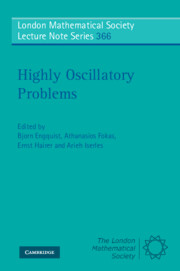Book contents
- Frontmatter
- Contents
- Preface
- 1 Oscillations over long times in numerical Hamiltonian systems
- 2 Highly oscillatory quadrature
- 3 Rapid function approximation by modified Fourier series
- 4 Approximation of high frequency wave propagation problems
- 5 Wavelet-based numerical homogenization
- 6 Plane wave methods for approximating the time harmonic wave equation
- 7 Boundary integral methods in high frequency scattering
- 8 Novel analytical and numerical methods for elliptic boundary value problems
1 - Oscillations over long times in numerical Hamiltonian systems
Published online by Cambridge University Press: 07 September 2011
- Frontmatter
- Contents
- Preface
- 1 Oscillations over long times in numerical Hamiltonian systems
- 2 Highly oscillatory quadrature
- 3 Rapid function approximation by modified Fourier series
- 4 Approximation of high frequency wave propagation problems
- 5 Wavelet-based numerical homogenization
- 6 Plane wave methods for approximating the time harmonic wave equation
- 7 Boundary integral methods in high frequency scattering
- 8 Novel analytical and numerical methods for elliptic boundary value problems
Summary
Introduction
The numerical treatment of ordinary differential equations has continued to be a lively area of numerical analysis for more than a century, with interesting applications in various fields and rich theory. There are three main developments in the design of numerical techniques and in the analysis of the algorithms:
Non-stiff differential equations. In the 19th century (Adams, Bashforth, and later Runge, Heun and Kutta), numerical integrators have been designed that are efficient (high order) and easy to apply (explicit) in practical situations.
Stiff differential equations. In the middle of the 20th century one became aware that earlier developed methods are impractical for a certain class of differential equations (stiff problems) due to stability restrictions. New integrators (typically implicit) were needed as well as new theories for a better understanding of the algorithms.
Geometric numerical integration. In long-time simulations of Hamiltonian systems (molecular dynamics, astronomy) neither classical explicit methods nor implicit integrators for stiff problems give satisfactory results. In the last few decades, special numerical methods have been designed that preserve the geometric structure of the exact flow and thus have an improved long-time behaviour.
The basic developments (algorithmic and theoretical) of these epochs are documented in the monographs [HNW93], [HW96], and [HLW06]. Within geometric numerical integration we can also distinguish between non-stiff and stiff situations. Since here the main emphasis is on conservative Hamiltonian systems, the term “stiff” has to be interpreted as “highly oscillatory”.
- Type
- Chapter
- Information
- Highly Oscillatory Problems , pp. 1 - 24Publisher: Cambridge University PressPrint publication year: 2009
- 6
- Cited by

